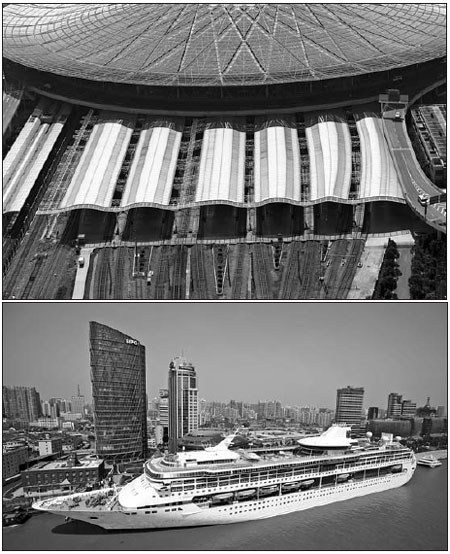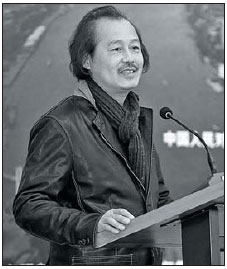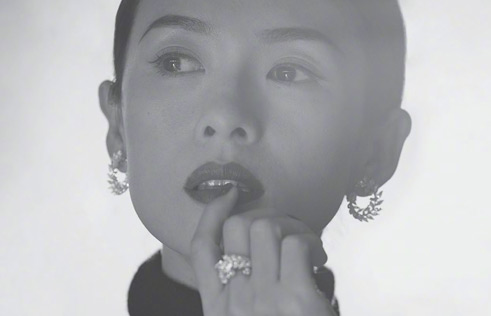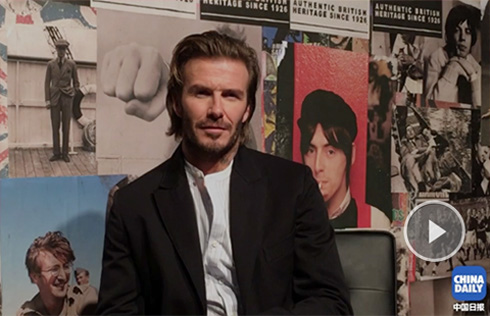'Explosion of sights'
|
Lujiazui, Pudong. Photos by Deke Erh / for China Daily |
|
Above: The Shanghai Southern Railway Station. Below: The cruise dock at the northern Bund. |
|
Deke Erh at the opening ceremony of his Shanghai - A Bird's-eye View exhibition. Provided to China Daily |
Shanghai photographer Deke Erh has been documenting the visual history of his beloved home for some 30 years. His latest collection offers a view of this Expo city from high above ground. Zhang Zixuan reports.
Although Deke Erh wears many hats such as photographer, writer, publisher and businessman, he would rather describe himself as a bird that loves its nest. An exhibition of his photographs of a city he wouldn't be more familiar with, Deke Erh's Shanghai - A Bird's-eye View, is now on at the National Art Museum of China.
It features more than 120 black and white aerial photographs of Shanghai that Erh took during the Shanghai Expo 2010, which he describes as "an explosion of sights".
"I've witnessed two golden eras of Shanghai," says the 51-year-old, who has a special feeling for the city where he was born and raised. It has remained the subject matter of his photographic works for more than 30 years.
Since the day in the mid-1970s when the then teenager's father gave him a Kodak camera, Erh has kept the film rolling.
"During the 'cultural revolution' (1966-1976), I could not see my future. So instead, I looked back. I looked at history," Erh says, explaining his interest in the old Shanghai cityscape.
"China's opening-up in the 1980s unfolded a new miracle in Shanghai, triggering an urge in me to capture fast-disappearing scenes with my camera."
At that time of frenzied demolishing and rebuilding, Erh raced against bulldozers with his lens. Using a 1:500 scale map of Shanghai as reference, he followed it to take photographs, house by house and lane by lane.
Through the 80s, Erh was using 80 rolls of film every month. By the 1990s, his monthly consumption of film had increased to 150 rolls.
Erh's first photo album A Last Look: Western Architecture in Old Shanghai, published in 1993, established his reputation for visual documentary. He has published more than 50 photo albums since. As one of the earliest Chinese freelance photographers and writers for foreign media, Erh made his first fortune from selling photos and articles, for which he got foreign currency, in the 1980s.
He poured these early riches and enthusiasm into his bold dream of documentary photography.
"In the early 1990s publishers wouldn't take the risk of publishing photo albums, which were not likely to sell," Erh recalls.
So he founded a Hong Kong-based press in 1990 to publish his photos, and set up a bookstore in Shanghai in 1992 as the distribution channel. He even built an art center to display his works all year long.
Sensing that his camera could not keep pace with the city's rapid change, he decided to use aerial photography.
Erh took every chance to get on all kinds of aircrafts, observing and documenting the city from above.
"Lujiazui used to be huge grassland with boundless rapeseeds fields. Now this is where the Oriental Pearl TV Tower, the new icon of Shanghai, stands," Erh says.
Most of the time Erh considers himself lucky to have witnessed such dramatic changes in just 30 years, something that can take two or three generations in other countries.
But sometimes, he also sees his experience as "unfortunate" in that so many scenes and traditional lifestyles - "the city's collective memory" - are disappearing every second under his nose, and he can do nothing to stop it.
"As a witness, the only thing I can do is document them in as much detail as possible," he says.
"Erh's works are significant for both art and history. They are an extension of the spirit of Shanghai," says Xia Guozhu, secretary general of China Friendship Art Exchange Association, organizer of the exhibition.
Erh is expanding his visual documentation nationwide and worldwide.
He has published several photo albums on China's treaty ports, churches, mission schools, banks, post offices and so on. He has been working for 10 years on the Silk Road, recreating the glory of an ancient culture through his photographs.

Erh has also been documenting the city's oral history. A few years ago he opened a tea house and welcomed elderly locals to share their stories of old Shanghai. He also managed to find 80 foreigners who lived in Shanghai before 1949 and invited them to come back and revisit the old places.
"Scenic photography documents the physical change of Shanghai while oral history remembers the spirit of a city," he says. "Things disappear in the real world, but they can still remain in people's minds."
(China Daily 01/01/2011 page8)





















